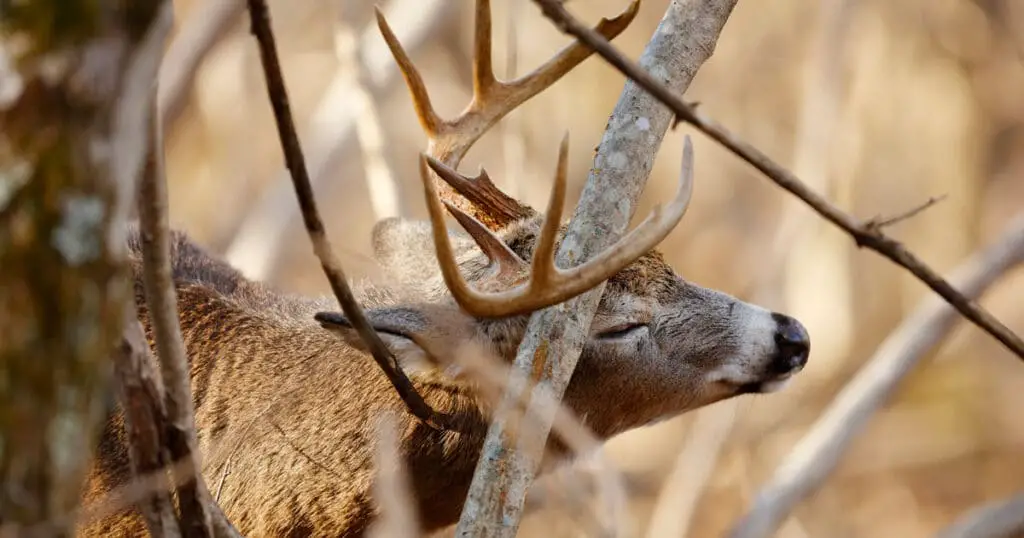Identifying deer signs is essential for successful hunting. They’re also useful for photographers, deer enthusiasts, and nature lovers. Scrapes are one of the most useful deer signs, and you should know how to identify them. Most people don’t even know what a deer scrape is. Let’s find out here.
Today we’ll go over everything you need to know about deer scrapes and other common deer signs you will find in the woods.
What is a Deer Scrape?
First of all, let’s go over what a deer scrape is. While female deer have been known to scrape, it’s primarily male deer (or bucks) that do the scraping.
Female deer scraping is probably random and doesn’t have much meaning. Buck scraping seems to be a behavior related to the rut (mating season).
Deer scrape occurs when a buck marks an area with his scent. The buck will normally begin by creating an oval-like scrape in the ground beside a tree. He will then rub his nose on a low-hanging branch and usually lick it. The process can take up to two minutes.
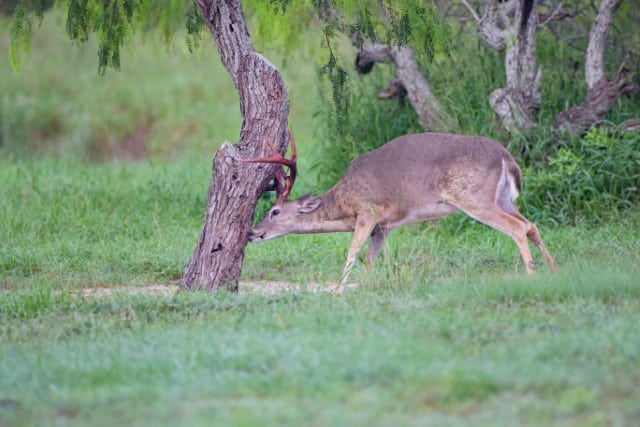
Once he’s done, he will urinate over the scrape.
Female deer will urinate over the same spot after the buck has passed. This signals to the buck that there are females ready to mate.
Why Do Deer Scrape?
As well as the mating facilitation function we talked about above, scrapes can be thought of as territory marking. Dogs and cats do something similar with urine.
When a deer licks the branch and rubs his nose over it, he is leaving his scent on the area.
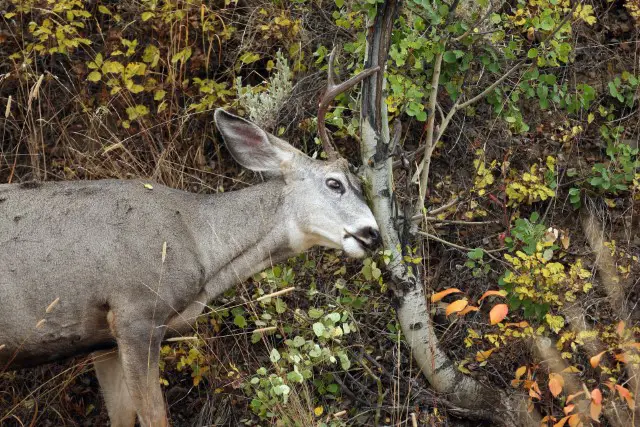
Keep in mind that deer have a much stronger sense of smell than humans. They have many more olfactory receptors than we do.
We might not be able to distinguish between the smells of different deer, but that’s not the case for deer. Think of it like each buck has his own unique cologne.
When he leaves his scent on a spot, his odor is unmistakable.
By exposing a female population to his scent, he marks his presence. He also allows the females to become adjusted to his scent.
The more the females become accustomed to his scent, the more they will like it.
How Often Does a Buck Visit a Scrape?
Bucks will visit a scrape multiple times throughout the year.
They will probably have multiple scrape spots. This spreads out their scent.
Scraping increases leading up to the rutting and mating season. The week before the mating season is a particularly popular time for scraping.
Bucks do more scraping this time of the year than at any other.
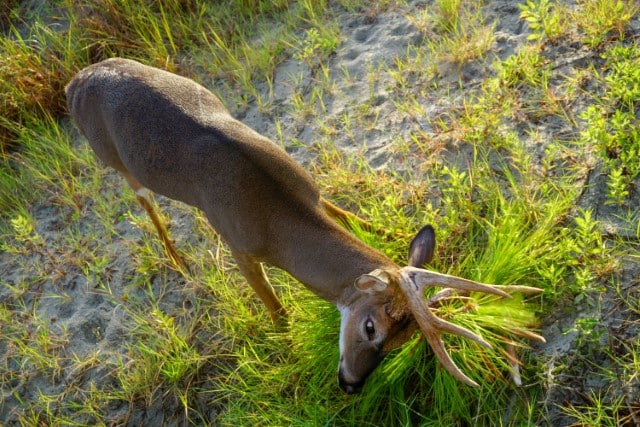
The frequency with which a buck visits a scrape varies. Some bucks have a wider territory than others.
A buck will scrape more frequently if it’s aggressively trying to mark his territory.
The age of a buck and his hormones also play a large role in scraping. Younger bucks that aren’t yet sexually mature won’t scrape as much as older ones.
Bucks do most of their scraping during their peak years for mating.
The fact that bucks do the most scraping shortly before mating suggests that this deer behavior is connected to mating.
Types of Deer Signs
Scrapes are one of the common deer signs.
There are many different types of deer signs. Before we get into those, let’s go over what a deer sign is.
If you’re new to hunting or haven’t scouted deer before, you need to understand this.
A deer sign is a sign that a deer leaves behind. When you’re out looking for deer, you’ll usually see signs before you see deer. Some deer signs are recent, whereas others fade. Both are important to understanding deer behavior.
Some of the main types of deer signs are:
- scrapes
- deer droppings
- bedding areas
- rubs
- deer tracks
The type of sign you should look for depends on what your purpose for finding deer is.
If you’re a determined hunter, you should actively be looking for all of these signs.
If you just want to spot some deer for fun, it’s probably enough just to understand droppings and tracks.
Photographers and researchers should be on the lookout for everything. And even if you’re just out for fun, you can never have too much information.
How Do You Read a Deer Sign?
The way you read a deer sign depends on the sign. Droppings and tracks are some of the most easily identifiable signs, so we’ll start with those.
Deer Droppings
Droppings are a fancy word for deer poop. Deer droppings are easily recognizable by their tiny, round shape.
You’ll normally find a cluster of deer droppings. They look similar to a bunch of grapes.
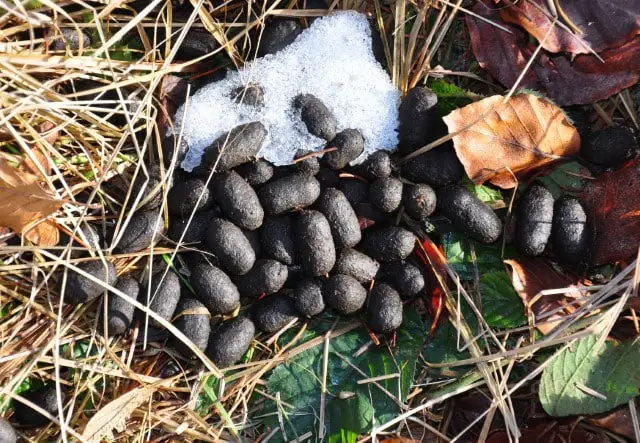
Deer droppings dry out quickly, so if you see droppings that look wet and moist, they’re probably fresh. Visibly dry droppings are probably at least a day old.
Deer droppings can easily be confused with rabbit or raccoon droppings.
All droppings smell bad, but deer droppings are so small that the smell is milder than that of other animals.
Droppings from other animals like dogs and horses look very different.
Deer Tracks
The next most easily recognizable sign is a deer track or footprint.
A deer track is an imprint left behind from deer hooves. You can normally tell the size of a deer based on its tracks.
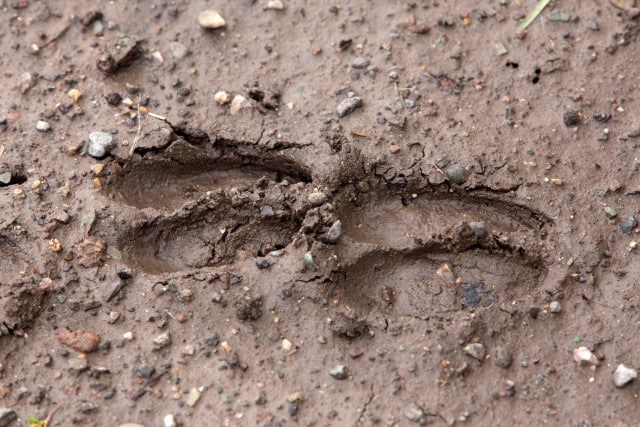
Deer have four hooves. If you measure the distance between the front and back hoof markings, you can estimate the size of the deer.
Keep in mind that deer do not walk like we do. They often jump and leap long distances, particularly when they run.
As a result, it’s not uncommon to find deer tracks spread far apart.
Deer tracks are easily disrupted by rain, other animals, and hikers. They can easily be covered by leaves or other foliage.
If you find perfectly intact tracks, it probably means the deer was in the area recently.
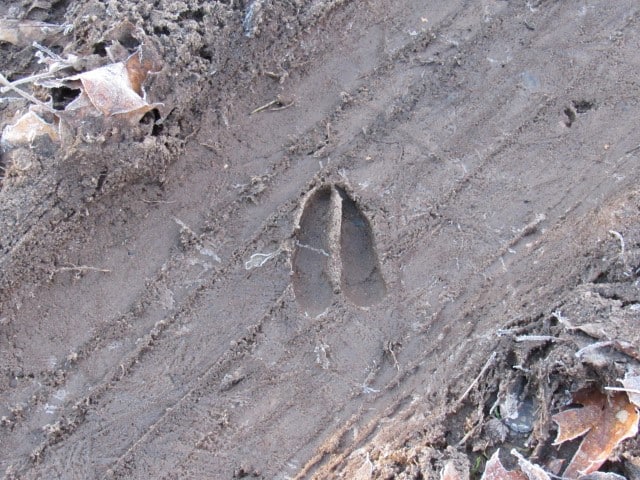
Following deer tracks and droppings will give you an idea of the direction a deer has gone. You can also determine this information from dear scrapes and rubs.
Deer Scrape vs Rub
While some hunters use the terms scrape and rub interchangeably, this isn’t technically accurate. A deer scrape is a spot where a deer performs the ritual we described earlier.
A deer rub, on the other hand, is when a buck rubs its forehead into a spot on a branch. During the fall, bucks will stretch out their necks by rubbing their foreheads and antlers against trees.
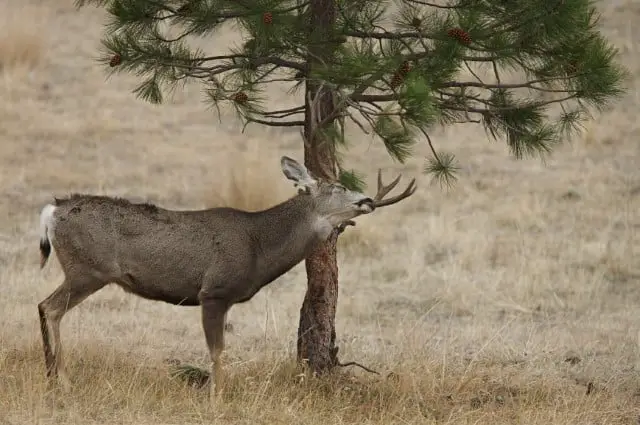
This serves to sharpen their antlers and strengthen their neck muscles.
The deer rub occurs only on the tree. The buck doesn’t lick or urinate over this area.
Rubbing serves a similar purpose to scraping. It helps a buck mark his territory and leave his scent in an area.
It also occurs mostly prior to the rutting and mating season. So, the reasons for rubbing and scraping are almost the same.
However, they are not exactly the same thing. You can usually gain more information from a deer rub than a deer scrape.
Deer Rub
Experienced hunters can guess the size of the buck’s antlers based on the size of the deer rub. For trophy hunters, this is very important information.
Generally speaking, bigger antlers mean bigger bucks.
If you find signs of deer rub, look around for markings on similar trees. This can give you an idea of which direction the buck was headed in.
If you find many signs of deer rubbing, you’ve probably found the buck’s core area.
Bucks are territorial creatures. They often return to bed in the same spot.
If they’ve rubbed in a particular area, chances are that they will sleep there as well.
You should be able to distinguish between fresh and old deer rubs. Fresh deer rubs have occurred within the past few hours.
Depending on the type of tree, you’ll be able to see some sap coming out. The smell will be fresh and the wood will be bright.
There will be bark missing. Old rubs will still show the missing bark, but the color will have faded.
Bark will have started to grow over the rubbing spot.
If you find lots of fresh rubs, you’ve found a good spot for hunting deer. Look for other deer signs nearby like deer bedding.
Deer Bedding Signs
A deer bed doesn’t look as comfortable as a human bed, but deer don’t sleep like we do.
A deer doesn’t need a blanket to stay warm. The warm coat of fur does that.
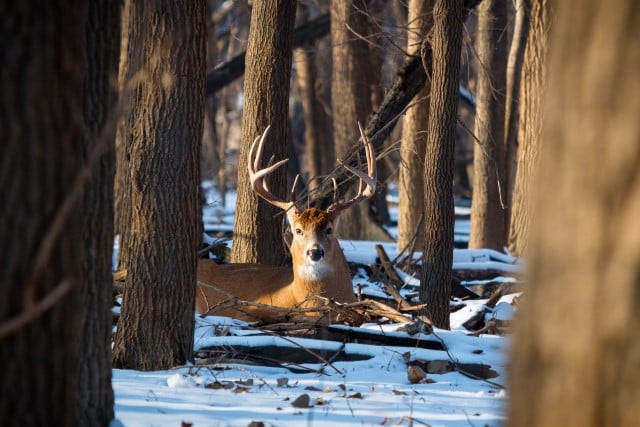
Still, deer try to make things as comfortable as possible. They will usually clear some of the grass and adjust things.
Where Do Deer Bed Down?
Hillsides and areas with a slight slope are preferred. During the winter, deer will often huddle down in the snow for warmth.
This protects the deer from the cold of the wind. Staying downwind will also keep the deer’s scent from spreading and alerting potential predators.
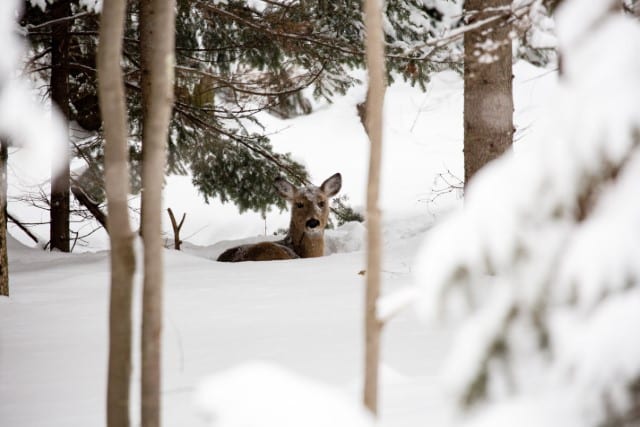
Deer are most at risk when they are asleep. A deer bed is designed for protection more than for comfort.
Deer beds are most likely to be found in well-protected areas. They are also likely to have a good escape route.
The middle of a meadow is probably not the best spot, but right in the middle of a forest is not ideal either.
The edge of a forest is more ideal.
Water is essential for survival. It will also block their scent from predators like wolves.
Deer are likely to bed close to a stream or lake so that they will have access to water if they get thirsty, and they’ll look for areas with plenty of good food to consume as well.
Deer scrapes and rubs are all signs that a deer bed might be nearby. When you’ve identified that deer are in the area, look for a bed.
Differences Between Buck and Doe Beds
A buck’s bed is different from a doe’s.
Bucks are more solitary than does. Their beds will be bigger as well, because most male deer are larger than their female counterparts.
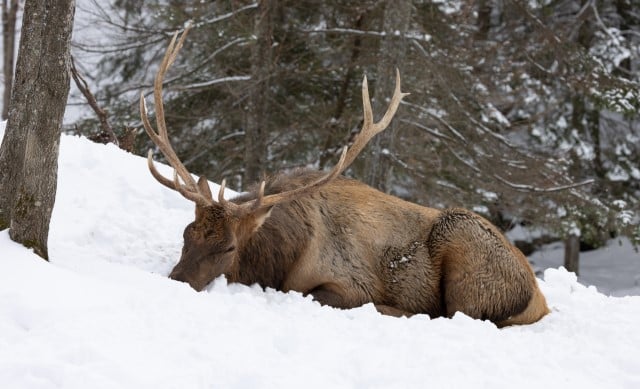
A doe’s bed will be smaller and you’re more likely to find other beds nearby. A mother deer’s bed will have space for her fawns.
Deer beds are oval and, unsurprisingly, about the size of a deer. They can be a bit hard to spot at first.
Once you’ve seen a few, you’ll start finding them without even looking for them.
Why You Should Search for Deer Beds?
Deer are less alert when they’re sleeping. This makes a deer bed an ideal hunting location.
If you know that a buck likes to sleep in a particular area, you’re more likely to catch him off guard.
If you aren’t a hunter, finding deer beds is a good way to figure out where to look for them. You’re more likely to snap some good photos when deer are asleep.
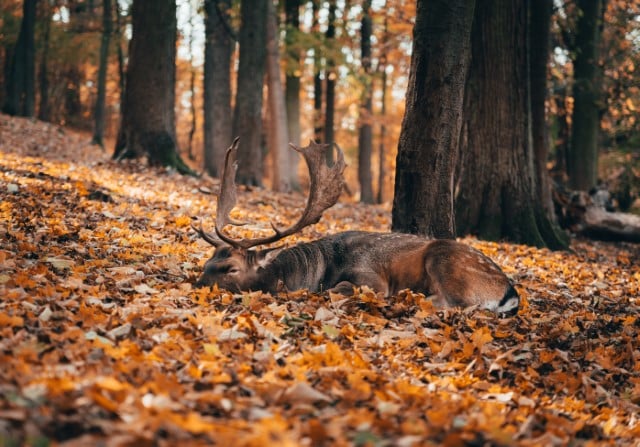
While deer tend to have multiple beds, they often return to the same spot more than once.
Deer are creatures of habit. Once they find a place that suits them, they’ll come back.
Keep in mind that deer sleep for large parts of the day. They aren’t always asleep at night, and deer are not nocturnal either.
It isn’t uncommon for deer to have a separate night and day bed.
In fact, they could have multiple beds spread throughout their territory. The more beds you find, the more likely it is that you’ve found a good area.
Now You Know How to Identify Deer Scrapes and Other Signs
Deer signs can be tricky to master. But you’ve got to get the knack of finding them if you want to be a successful hunter.
Let’s review the most important types of deer signs:
- scrapes
- droppings
- tracks
- rubs
- beds
Droppings and tracks are the most easily recognizable signs for beginners. More experienced hunters and enthusiasts will find rubs and scrapes and beds.
Once you’ve learned how to recognize these signs, you’ll start seeing them everywhere.
It’s time to get out there and get looking!

